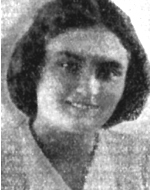Zeltzer (Reiss), Rachel (Alotschka)
Was born on August 29, 1927, in the city of Korczak-Butoshny, on the border between Romania and Bessarabia, in an agricultural estate belonging to the family, and was transferred to Czernowitz, to which her mother passed away after she separated from her husband. Chile, where he studied medicine and worked as a dentist, a chemist by profession, who came from a wealthy family, lived in comfortable conditions with her daughter, educated and raised her in the spirit of advanced Russian culture, in an atmosphere of art and music. She was always the first to excel in the class, healthy and Simcha, self-confident, severely affected by the Romanian spirit of Romanian youth in school and racial discrimination, and decided to But with the Russian occupation (1940) she continued her studies and came to a higher class thanks to her talents.Rachel had a wonderful memory, memorized entire columns of Russian poetry and remembered them all her life. The Germans occupied Czernowitz and she and her mother were transferred to the ghetto, where they barely made a living from hard labor, but because of the informant they were suspected of collaborating with the Russians and the Germans sent the mother to a concentration camp in Transnistria. limit. The girl was sent on a small illegal immigrant ship L’Esperance in November 1942. The ship was blown up by the Turkish coast, and its passengers were rescued and transferred with the help of the Jewish Agency to a small town in Turkey and from there to Cyprus; Rachel immigrated directly from this town to Israel on the basis of a certificate sent to her by her aunt from Jerusalem at the end of 1942. She studied at a high school and finished seventh grade at the Beit Hakerem Gymnasium, and thanks to her talents, she successfully passed the university entrance exams and was accepted in 1945 as a student in the Department of Natural Sciences . That same year, her mother, who was saved from the camps and they were told to live together, arrived in Israel, but at the outbreak of the War of Independence, Rachel enlisted with her fellow students for full service. At first she served in the Jerusalem Battalions and, at her energetic demand to participate in combat activities, was transferred to a group of students to Gush Etzion, where she took an active part in guarding and defending the Gush. – Deep revenge. After three months of service in the Gush, the group was replaced by other students, and they returned to Jerusalem in a convoy that was severely attacked in Nabi Daniel and stood heroically in a single house opposite crowds. After a 24-hour struggle, the besieged were rescued by the English, with humiliating surrender and the surrender of the defensive weapons to their hands. Rachel was deeply hurt in her honor, and when she returned she demanded that she be annexed to a combat unit. As the Haganah ceased to share girls in battle, it joined the Lehi and two weeks later, when it went out with them as a sniper to the Jaffa Gate, fell in battle for heroism on Friday, May 15, 1948. She was buried in Sanhedria. On the 18th of Av 5711 (20.9.1951) she was put to rest in the military cemetery at Mount Herzl in Jerusalem.
